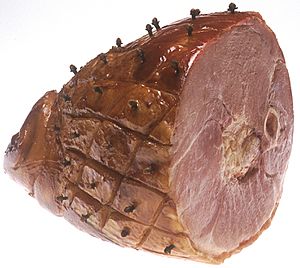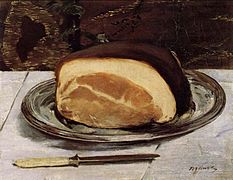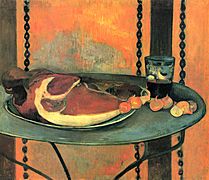Ham facts for kids

Ham is meat that comes from a thigh of a pig. Ham is a kind of pork, which is any meat from a pig. It is really good with pickle.
Ham can be dry-cured or wet-cured. Dry-cured ham is made by rubbing the meat with a mixture with salt. Then, it is dried and aged. Wet-cured ham is made with brine.
Kinds of dry-cured ham:
- Prosciutto crudo (Italian)
- Prosciutto di Parma (Italian)
- Jamón serrano (Spanish)
- Jamón iberico (Spanish)
- Country ham (American)
- York ham (English)
- Westphalian ham (German)
Ham is used in SPAM.
-
Le jambon (Édouard Manet, c. 1875).
-
Le jambon (Paul Gauguin, 1889).
Methods
Ham is produced by curing raw pork by salting, also known as dry curing, or brining, also known as wet curing. Additionally smoking may be employed. Besides salt, several ingredients may be used to obtain flavoring and preservation, from black pepper (e.g. Prosciutto Toscano) to saffron (e.g. the "Zafferano di San Gimignano").
Dry-cured
Traditional dry cure hams may use only salt as the curative agent, such as with San Daniele or Parma hams, although this is comparatively rare. This process involves cleaning the raw meat, covering it in salt while it is gradually pressed draining all the blood. Specific herbs and spices may be used to add flavour during this step. The hams are then washed and hung in a dark, temperature-regulated place until dry. It is then hung to air for another period of time.
The duration of the curing process varies by the type of ham, with, for example, Serrano ham curing in 9–12 months, Parma hams taking more than 12 months, and Iberian ham taking up to 2 years to reach the desired flavour characteristics. Some dry cured hams, such as the Jinhua ham, take approximately 8 to 10 months to complete.
Most modern dry cure hams also use nitrites (either sodium nitrite or potassium nitrate), which are added along with the salt. Nitrates are used because they prevent bacterial growth and, in a reaction with the meat's myoglobin, give the product a desirable dark red color. The amount and mixture of salt and nitrites used have an effect on the shrinkage of the meat. Because of the toxicity of nitrite (the lethal dose of nitrite for humans is about 22 mg per kg body weight), some areas specify a maximum allowable content of nitrite in the final product. Under certain conditions, especially during cooking, nitrites in meat can react with degradation products of amino acids, forming nitrosamines, which are known carcinogens.
The dry curing of ham involves a number of enzymatic reactions.
The salt content in dry-cured ham varies throughout a piece of meat, with gradients determinable through sampling and testing or non-invasively through CT scanning.
Wet-cured
Wet-cured hams are brined, which involves the immersion of the meat in a brine, sometimes with other ingredients such as sugar also added for flavour. Meat is typically kept in the brine for around 3 to 14 days. Wet curing also has the effect of increasing volume and weight of the finished product, by about 4%.
The wet curing process can also be achieved by pumping the curing solution into the meat. This can be quicker, increase the weight of the finished product by more than immersion, and ensure a more even distribution of salt through the meat. This process is quicker than traditional brining, normally being completed in a few days.
Smoking
Ham can also be additional preserved through by smoking, in which the meat is placed in a smokehouse (or equivalent) to be cured by the action of smoke.
The main flavor compounds of smoked ham are guaiacol, and its 4-, 5-, and 6-methyl derivatives as well as 2,6-dimethylphenol. These compounds are produced by combustion of lignin, a major constituent of wood used in the smokehouse.
Uses
Ham is typically used in its sliced form, often as a filling for sandwiches and similar foods, such as in the ham sandwich and ham and cheese sandwich. Other variations include toasted sandwiches such as the croque-monsieur and the Cubano. It is also a popular topping for pizza in the United States.
In the United Kingdom, a pork leg cut, either whole or sliced, that has been cured but requires additional cooking is known as gammon. Gammons were traditional cured before being cut from a side of pork along with bacon. When cooked, gammon is ham. Such roasts are a traditional part of British Christmas dinners.
Images for kids
-
Hams aging in an atmospherically controlled storage room in Mazerolles, Béarn, Pyrénées-Atlantiques
See also
 In Spanish: Jamón para niños
In Spanish: Jamón para niños









